Project Analysis: TESCO's New Outlet Store Initiative
VerifiedAdded on 2020/10/05
|14
|4196
|205
Report
AI Summary
This report provides a comprehensive analysis of TESCO's project planning and management strategies, focusing on the proposed launch of a new outlet store. The report begins with an introduction to business administration and its application to TESCO, highlighting key aspects such as cost-benefit analysis, risk analysis techniques, and the use of project planning tools. It delves into the impacts of changes to project scope, schedule, finance, risk, quality, and resources, along with an analysis of project governance arrangements. The report also examines how the project aligns with TESCO's overall vision and objectives, emphasizing the importance of stakeholder engagement and the development of SMART objectives and key performance indicators (KPIs). Furthermore, the report addresses the interdependencies and potential risks within the project, along with the development of proportionate and targeted plans to manage identified risks and contingencies. The report concludes with an overview of resource allocation, project team roles, and communication strategies, as well as the importance of organizational policies, procedures, and ethical requirements in project management. Periodic reviews and the effectiveness of capturing and managing project-related knowledge are also discussed. The report uses various resources to analyze the project planning and management of TESCO’s new outlet store.
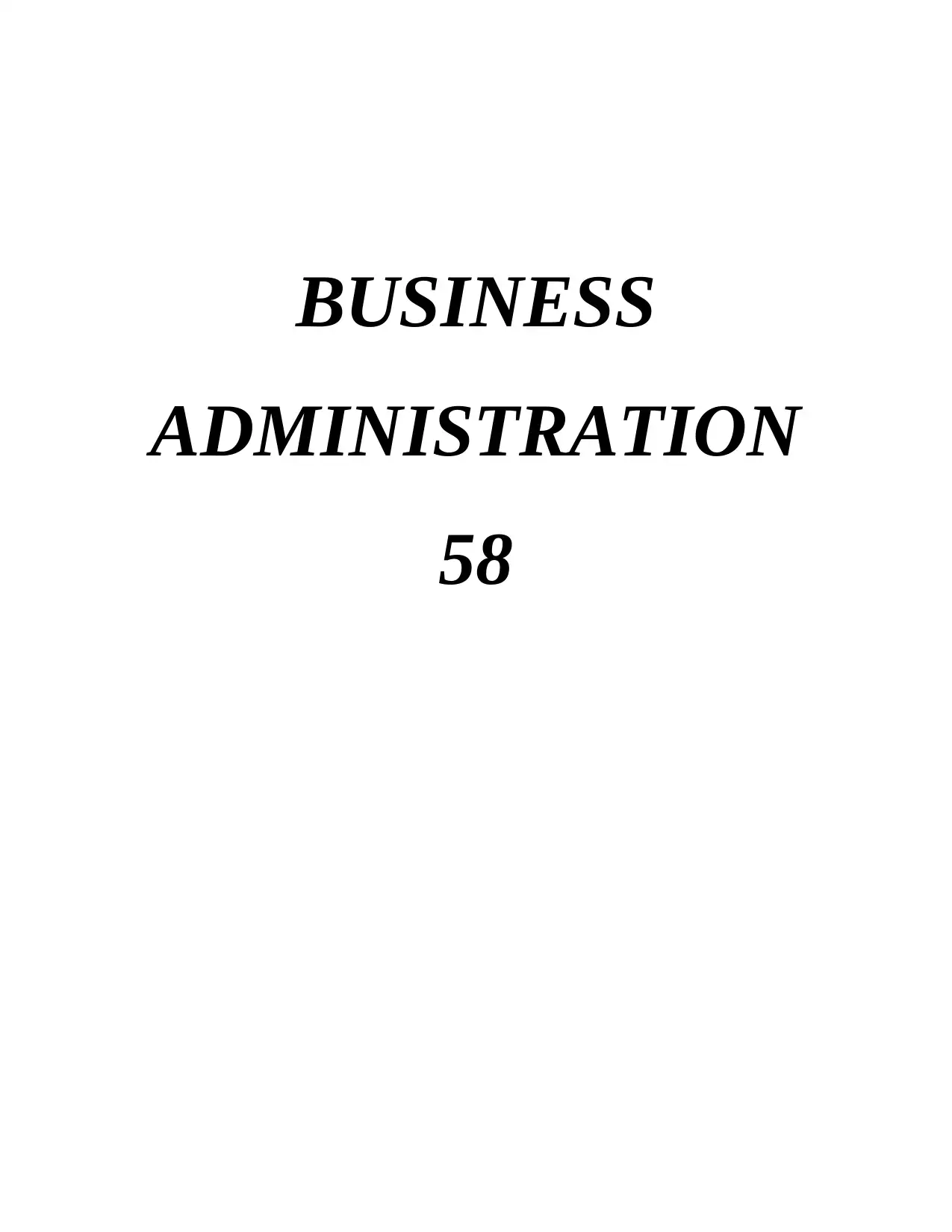
BUSINESS
ADMINISTRATION
58
ADMINISTRATION
58
Paraphrase This Document
Need a fresh take? Get an instant paraphrase of this document with our AI Paraphraser
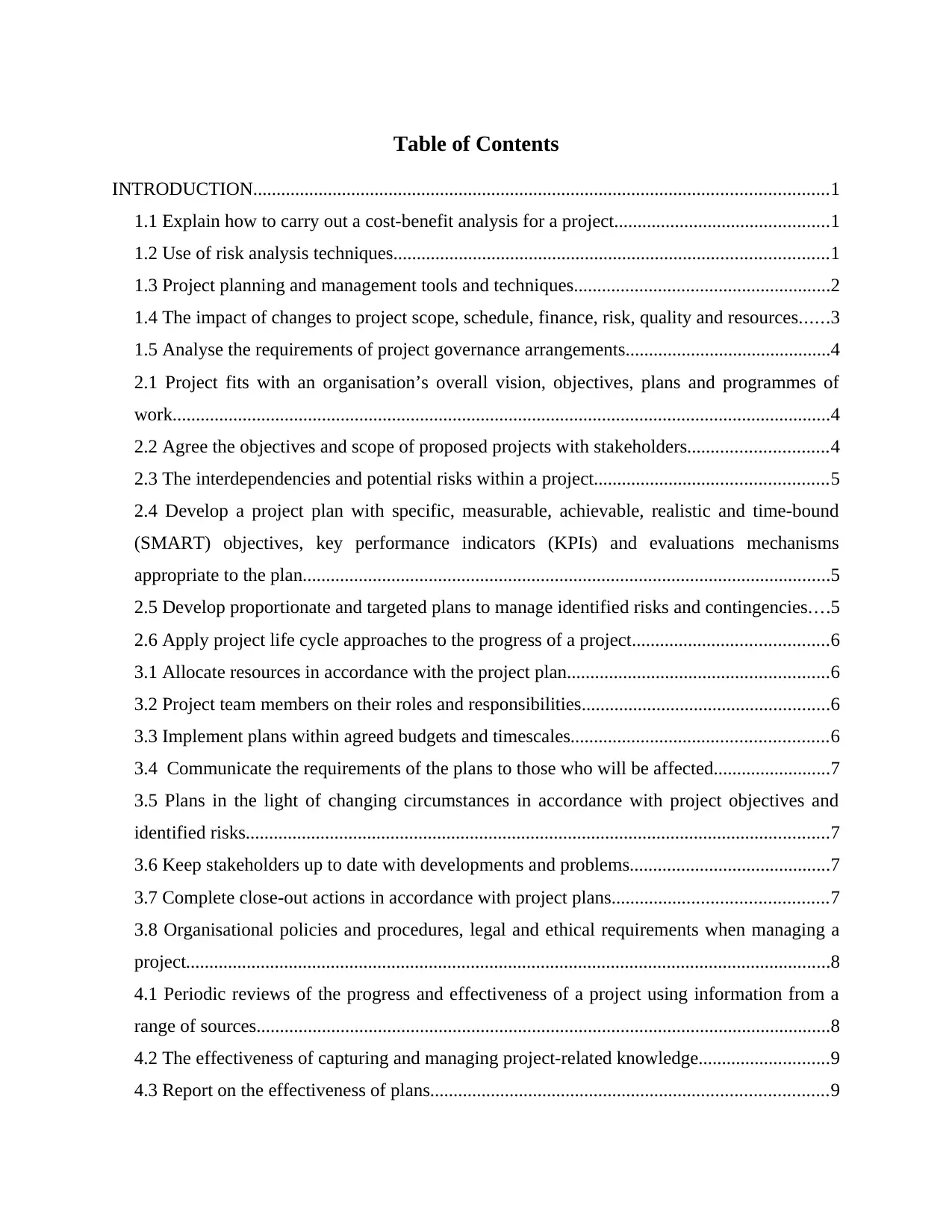
Table of Contents
INTRODUCTION...........................................................................................................................1
1.1 Explain how to carry out a cost-benefit analysis for a project..............................................1
1.2 Use of risk analysis techniques.............................................................................................1
1.3 Project planning and management tools and techniques.......................................................2
1.4 The impact of changes to project scope, schedule, finance, risk, quality and resources......3
1.5 Analyse the requirements of project governance arrangements............................................4
2.1 Project fits with an organisation’s overall vision, objectives, plans and programmes of
work.............................................................................................................................................4
2.2 Agree the objectives and scope of proposed projects with stakeholders..............................4
2.3 The interdependencies and potential risks within a project..................................................5
2.4 Develop a project plan with specific, measurable, achievable, realistic and time-bound
(SMART) objectives, key performance indicators (KPIs) and evaluations mechanisms
appropriate to the plan.................................................................................................................5
2.5 Develop proportionate and targeted plans to manage identified risks and contingencies....5
2.6 Apply project life cycle approaches to the progress of a project..........................................6
3.1 Allocate resources in accordance with the project plan........................................................6
3.2 Project team members on their roles and responsibilities.....................................................6
3.3 Implement plans within agreed budgets and timescales.......................................................6
3.4 Communicate the requirements of the plans to those who will be affected.........................7
3.5 Plans in the light of changing circumstances in accordance with project objectives and
identified risks.............................................................................................................................7
3.6 Keep stakeholders up to date with developments and problems...........................................7
3.7 Complete close-out actions in accordance with project plans..............................................7
3.8 Organisational policies and procedures, legal and ethical requirements when managing a
project..........................................................................................................................................8
4.1 Periodic reviews of the progress and effectiveness of a project using information from a
range of sources...........................................................................................................................8
4.2 The effectiveness of capturing and managing project-related knowledge............................9
4.3 Report on the effectiveness of plans.....................................................................................9
INTRODUCTION...........................................................................................................................1
1.1 Explain how to carry out a cost-benefit analysis for a project..............................................1
1.2 Use of risk analysis techniques.............................................................................................1
1.3 Project planning and management tools and techniques.......................................................2
1.4 The impact of changes to project scope, schedule, finance, risk, quality and resources......3
1.5 Analyse the requirements of project governance arrangements............................................4
2.1 Project fits with an organisation’s overall vision, objectives, plans and programmes of
work.............................................................................................................................................4
2.2 Agree the objectives and scope of proposed projects with stakeholders..............................4
2.3 The interdependencies and potential risks within a project..................................................5
2.4 Develop a project plan with specific, measurable, achievable, realistic and time-bound
(SMART) objectives, key performance indicators (KPIs) and evaluations mechanisms
appropriate to the plan.................................................................................................................5
2.5 Develop proportionate and targeted plans to manage identified risks and contingencies....5
2.6 Apply project life cycle approaches to the progress of a project..........................................6
3.1 Allocate resources in accordance with the project plan........................................................6
3.2 Project team members on their roles and responsibilities.....................................................6
3.3 Implement plans within agreed budgets and timescales.......................................................6
3.4 Communicate the requirements of the plans to those who will be affected.........................7
3.5 Plans in the light of changing circumstances in accordance with project objectives and
identified risks.............................................................................................................................7
3.6 Keep stakeholders up to date with developments and problems...........................................7
3.7 Complete close-out actions in accordance with project plans..............................................7
3.8 Organisational policies and procedures, legal and ethical requirements when managing a
project..........................................................................................................................................8
4.1 Periodic reviews of the progress and effectiveness of a project using information from a
range of sources...........................................................................................................................8
4.2 The effectiveness of capturing and managing project-related knowledge............................9
4.3 Report on the effectiveness of plans.....................................................................................9

CONCLUSION................................................................................................................................9
REFERENCES..............................................................................................................................10
REFERENCES..............................................................................................................................10
⊘ This is a preview!⊘
Do you want full access?
Subscribe today to unlock all pages.

Trusted by 1+ million students worldwide
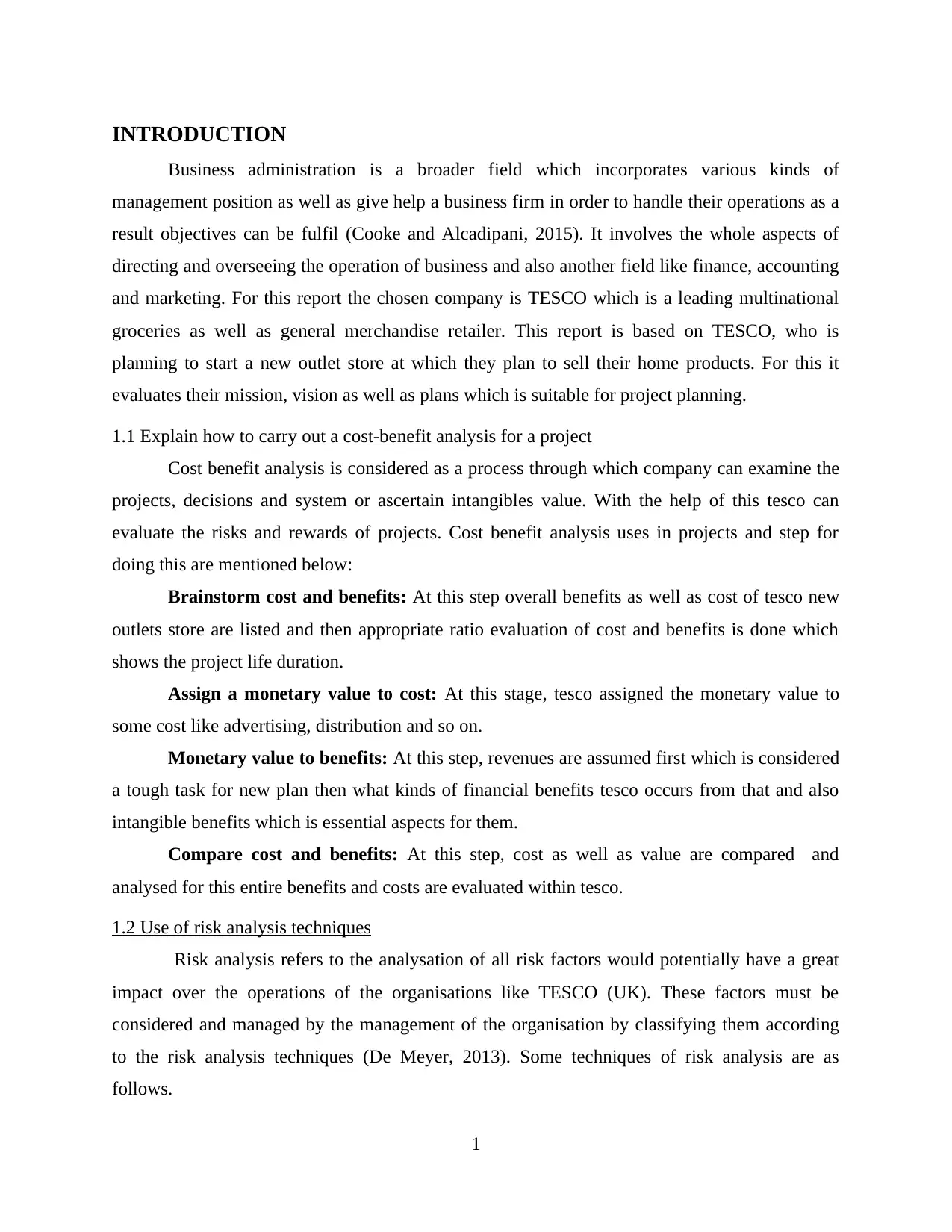
INTRODUCTION
Business administration is a broader field which incorporates various kinds of
management position as well as give help a business firm in order to handle their operations as a
result objectives can be fulfil (Cooke and Alcadipani, 2015). It involves the whole aspects of
directing and overseeing the operation of business and also another field like finance, accounting
and marketing. For this report the chosen company is TESCO which is a leading multinational
groceries as well as general merchandise retailer. This report is based on TESCO, who is
planning to start a new outlet store at which they plan to sell their home products. For this it
evaluates their mission, vision as well as plans which is suitable for project planning.
1.1 Explain how to carry out a cost-benefit analysis for a project
Cost benefit analysis is considered as a process through which company can examine the
projects, decisions and system or ascertain intangibles value. With the help of this tesco can
evaluate the risks and rewards of projects. Cost benefit analysis uses in projects and step for
doing this are mentioned below:
Brainstorm cost and benefits: At this step overall benefits as well as cost of tesco new
outlets store are listed and then appropriate ratio evaluation of cost and benefits is done which
shows the project life duration.
Assign a monetary value to cost: At this stage, tesco assigned the monetary value to
some cost like advertising, distribution and so on.
Monetary value to benefits: At this step, revenues are assumed first which is considered
a tough task for new plan then what kinds of financial benefits tesco occurs from that and also
intangible benefits which is essential aspects for them.
Compare cost and benefits: At this step, cost as well as value are compared and
analysed for this entire benefits and costs are evaluated within tesco.
1.2 Use of risk analysis techniques
Risk analysis refers to the analysation of all risk factors would potentially have a great
impact over the operations of the organisations like TESCO (UK). These factors must be
considered and managed by the management of the organisation by classifying them according
to the risk analysis techniques (De Meyer, 2013). Some techniques of risk analysis are as
follows.
1
Business administration is a broader field which incorporates various kinds of
management position as well as give help a business firm in order to handle their operations as a
result objectives can be fulfil (Cooke and Alcadipani, 2015). It involves the whole aspects of
directing and overseeing the operation of business and also another field like finance, accounting
and marketing. For this report the chosen company is TESCO which is a leading multinational
groceries as well as general merchandise retailer. This report is based on TESCO, who is
planning to start a new outlet store at which they plan to sell their home products. For this it
evaluates their mission, vision as well as plans which is suitable for project planning.
1.1 Explain how to carry out a cost-benefit analysis for a project
Cost benefit analysis is considered as a process through which company can examine the
projects, decisions and system or ascertain intangibles value. With the help of this tesco can
evaluate the risks and rewards of projects. Cost benefit analysis uses in projects and step for
doing this are mentioned below:
Brainstorm cost and benefits: At this step overall benefits as well as cost of tesco new
outlets store are listed and then appropriate ratio evaluation of cost and benefits is done which
shows the project life duration.
Assign a monetary value to cost: At this stage, tesco assigned the monetary value to
some cost like advertising, distribution and so on.
Monetary value to benefits: At this step, revenues are assumed first which is considered
a tough task for new plan then what kinds of financial benefits tesco occurs from that and also
intangible benefits which is essential aspects for them.
Compare cost and benefits: At this step, cost as well as value are compared and
analysed for this entire benefits and costs are evaluated within tesco.
1.2 Use of risk analysis techniques
Risk analysis refers to the analysation of all risk factors would potentially have a great
impact over the operations of the organisations like TESCO (UK). These factors must be
considered and managed by the management of the organisation by classifying them according
to the risk analysis techniques (De Meyer, 2013). Some techniques of risk analysis are as
follows.
1
Paraphrase This Document
Need a fresh take? Get an instant paraphrase of this document with our AI Paraphraser
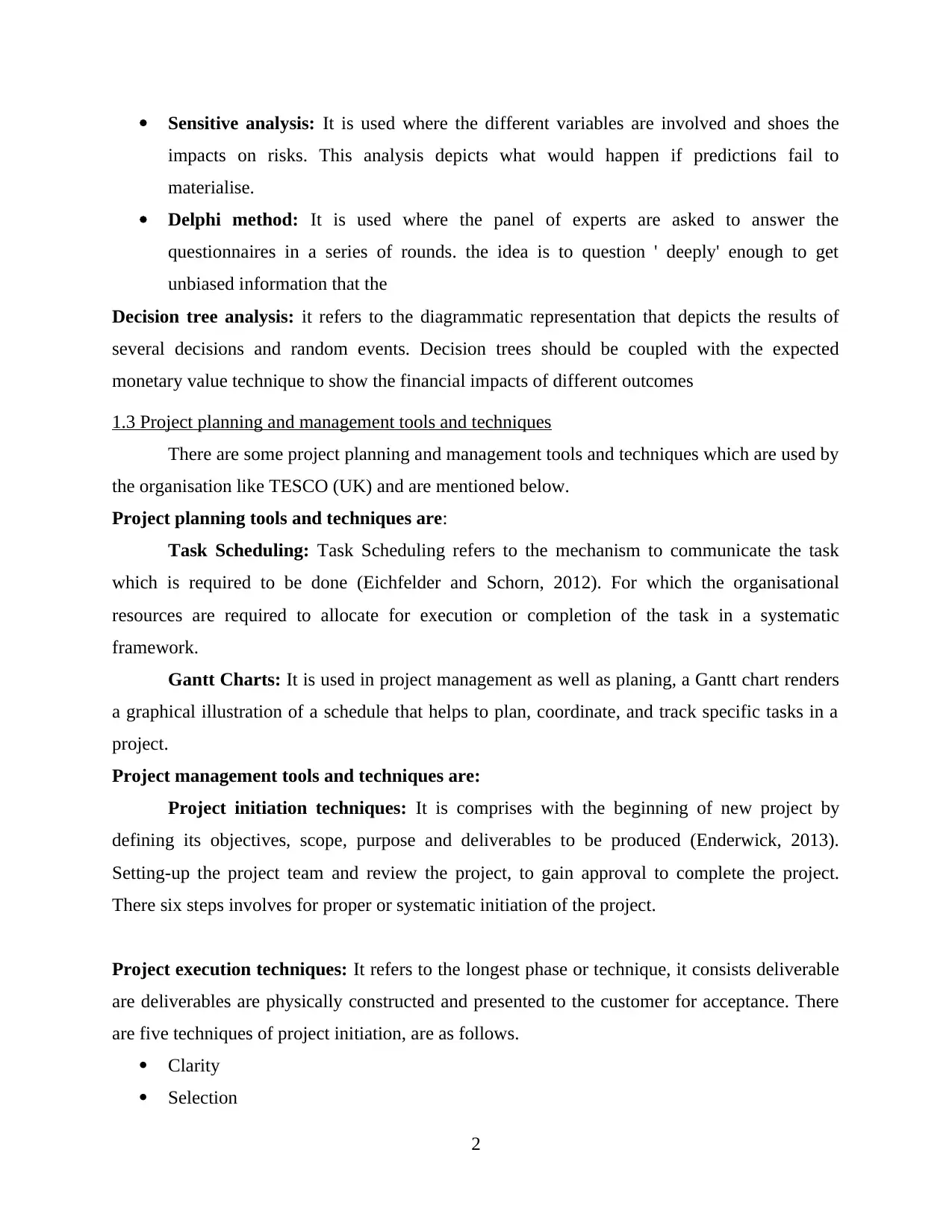
Sensitive analysis: It is used where the different variables are involved and shoes the
impacts on risks. This analysis depicts what would happen if predictions fail to
materialise.
Delphi method: It is used where the panel of experts are asked to answer the
questionnaires in a series of rounds. the idea is to question ' deeply' enough to get
unbiased information that the
Decision tree analysis: it refers to the diagrammatic representation that depicts the results of
several decisions and random events. Decision trees should be coupled with the expected
monetary value technique to show the financial impacts of different outcomes
1.3 Project planning and management tools and techniques
There are some project planning and management tools and techniques which are used by
the organisation like TESCO (UK) and are mentioned below.
Project planning tools and techniques are:
Task Scheduling: Task Scheduling refers to the mechanism to communicate the task
which is required to be done (Eichfelder and Schorn, 2012). For which the organisational
resources are required to allocate for execution or completion of the task in a systematic
framework.
Gantt Charts: It is used in project management as well as planing, a Gantt chart renders
a graphical illustration of a schedule that helps to plan, coordinate, and track specific tasks in a
project.
Project management tools and techniques are:
Project initiation techniques: It is comprises with the beginning of new project by
defining its objectives, scope, purpose and deliverables to be produced (Enderwick, 2013).
Setting-up the project team and review the project, to gain approval to complete the project.
There six steps involves for proper or systematic initiation of the project.
Project execution techniques: It refers to the longest phase or technique, it consists deliverable
are deliverables are physically constructed and presented to the customer for acceptance. There
are five techniques of project initiation, are as follows.
Clarity
Selection
2
impacts on risks. This analysis depicts what would happen if predictions fail to
materialise.
Delphi method: It is used where the panel of experts are asked to answer the
questionnaires in a series of rounds. the idea is to question ' deeply' enough to get
unbiased information that the
Decision tree analysis: it refers to the diagrammatic representation that depicts the results of
several decisions and random events. Decision trees should be coupled with the expected
monetary value technique to show the financial impacts of different outcomes
1.3 Project planning and management tools and techniques
There are some project planning and management tools and techniques which are used by
the organisation like TESCO (UK) and are mentioned below.
Project planning tools and techniques are:
Task Scheduling: Task Scheduling refers to the mechanism to communicate the task
which is required to be done (Eichfelder and Schorn, 2012). For which the organisational
resources are required to allocate for execution or completion of the task in a systematic
framework.
Gantt Charts: It is used in project management as well as planing, a Gantt chart renders
a graphical illustration of a schedule that helps to plan, coordinate, and track specific tasks in a
project.
Project management tools and techniques are:
Project initiation techniques: It is comprises with the beginning of new project by
defining its objectives, scope, purpose and deliverables to be produced (Enderwick, 2013).
Setting-up the project team and review the project, to gain approval to complete the project.
There six steps involves for proper or systematic initiation of the project.
Project execution techniques: It refers to the longest phase or technique, it consists deliverable
are deliverables are physically constructed and presented to the customer for acceptance. There
are five techniques of project initiation, are as follows.
Clarity
Selection
2
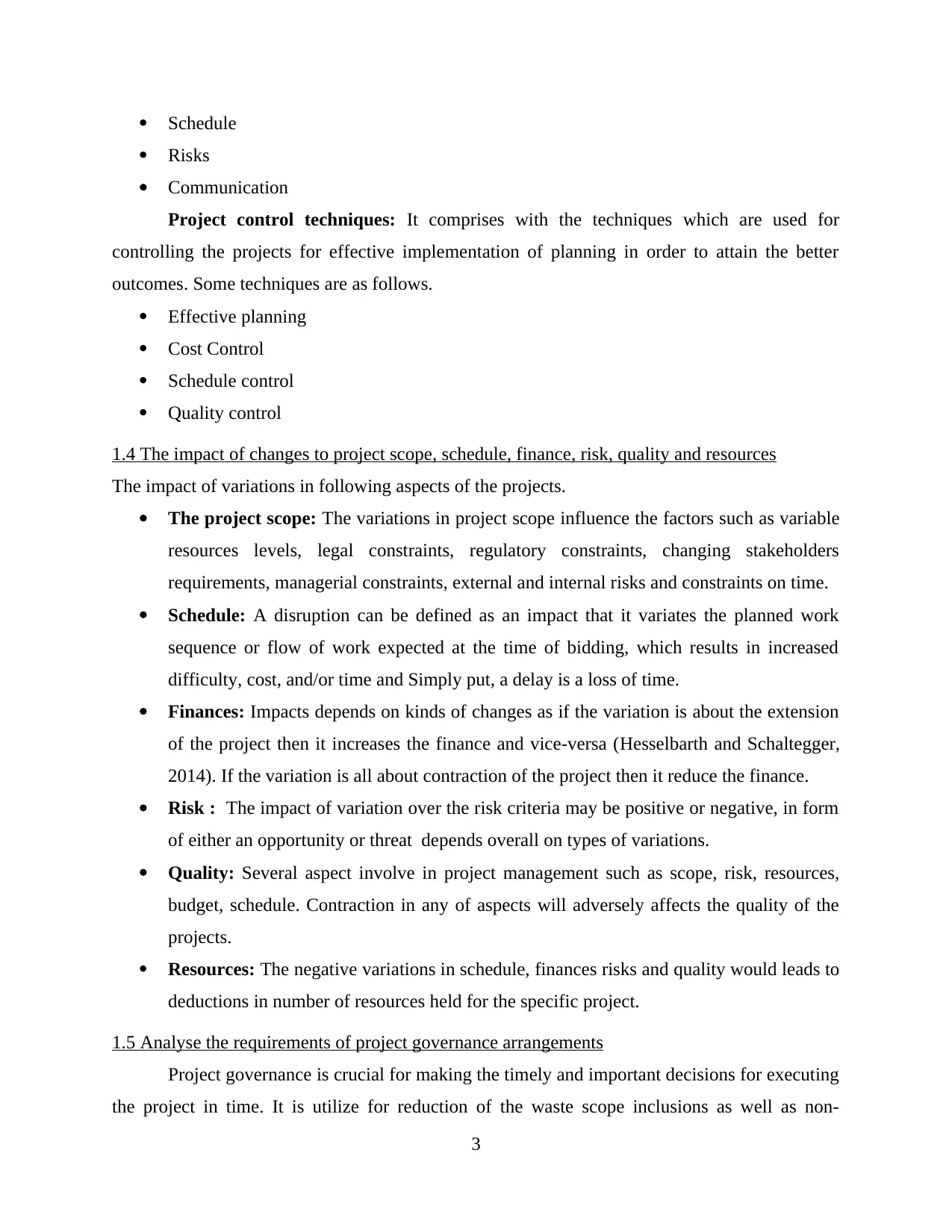
Schedule
Risks
Communication
Project control techniques: It comprises with the techniques which are used for
controlling the projects for effective implementation of planning in order to attain the better
outcomes. Some techniques are as follows.
Effective planning
Cost Control
Schedule control
Quality control
1.4 The impact of changes to project scope, schedule, finance, risk, quality and resources
The impact of variations in following aspects of the projects.
The project scope: The variations in project scope influence the factors such as variable
resources levels, legal constraints, regulatory constraints, changing stakeholders
requirements, managerial constraints, external and internal risks and constraints on time.
Schedule: A disruption can be defined as an impact that it variates the planned work
sequence or flow of work expected at the time of bidding, which results in increased
difficulty, cost, and/or time and Simply put, a delay is a loss of time.
Finances: Impacts depends on kinds of changes as if the variation is about the extension
of the project then it increases the finance and vice-versa (Hesselbarth and Schaltegger,
2014). If the variation is all about contraction of the project then it reduce the finance.
Risk : The impact of variation over the risk criteria may be positive or negative, in form
of either an opportunity or threat depends overall on types of variations.
Quality: Several aspect involve in project management such as scope, risk, resources,
budget, schedule. Contraction in any of aspects will adversely affects the quality of the
projects.
Resources: The negative variations in schedule, finances risks and quality would leads to
deductions in number of resources held for the specific project.
1.5 Analyse the requirements of project governance arrangements
Project governance is crucial for making the timely and important decisions for executing
the project in time. It is utilize for reduction of the waste scope inclusions as well as non-
3
Risks
Communication
Project control techniques: It comprises with the techniques which are used for
controlling the projects for effective implementation of planning in order to attain the better
outcomes. Some techniques are as follows.
Effective planning
Cost Control
Schedule control
Quality control
1.4 The impact of changes to project scope, schedule, finance, risk, quality and resources
The impact of variations in following aspects of the projects.
The project scope: The variations in project scope influence the factors such as variable
resources levels, legal constraints, regulatory constraints, changing stakeholders
requirements, managerial constraints, external and internal risks and constraints on time.
Schedule: A disruption can be defined as an impact that it variates the planned work
sequence or flow of work expected at the time of bidding, which results in increased
difficulty, cost, and/or time and Simply put, a delay is a loss of time.
Finances: Impacts depends on kinds of changes as if the variation is about the extension
of the project then it increases the finance and vice-versa (Hesselbarth and Schaltegger,
2014). If the variation is all about contraction of the project then it reduce the finance.
Risk : The impact of variation over the risk criteria may be positive or negative, in form
of either an opportunity or threat depends overall on types of variations.
Quality: Several aspect involve in project management such as scope, risk, resources,
budget, schedule. Contraction in any of aspects will adversely affects the quality of the
projects.
Resources: The negative variations in schedule, finances risks and quality would leads to
deductions in number of resources held for the specific project.
1.5 Analyse the requirements of project governance arrangements
Project governance is crucial for making the timely and important decisions for executing
the project in time. It is utilize for reduction of the waste scope inclusions as well as non-
3
⊘ This is a preview!⊘
Do you want full access?
Subscribe today to unlock all pages.

Trusted by 1+ million students worldwide
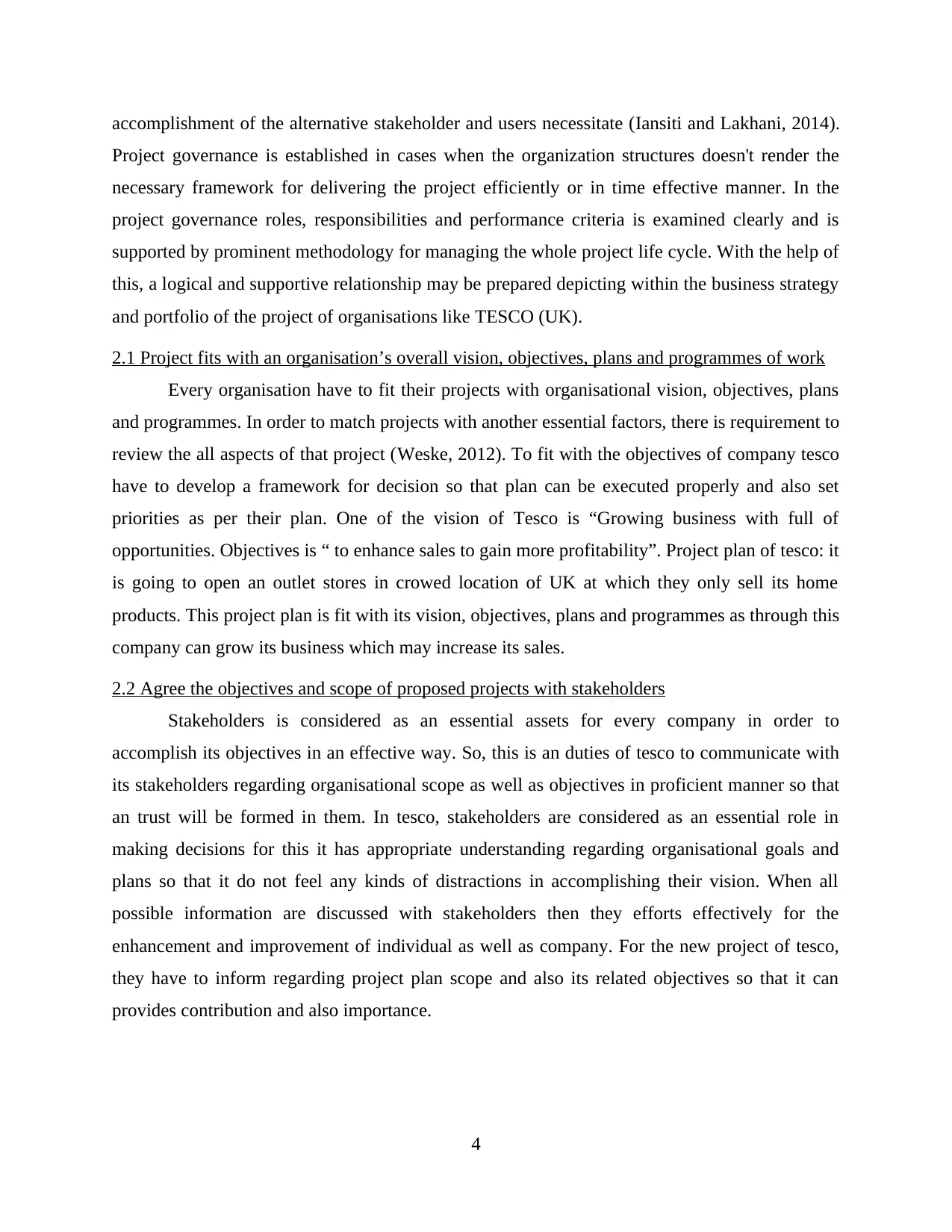
accomplishment of the alternative stakeholder and users necessitate (Iansiti and Lakhani, 2014).
Project governance is established in cases when the organization structures doesn't render the
necessary framework for delivering the project efficiently or in time effective manner. In the
project governance roles, responsibilities and performance criteria is examined clearly and is
supported by prominent methodology for managing the whole project life cycle. With the help of
this, a logical and supportive relationship may be prepared depicting within the business strategy
and portfolio of the project of organisations like TESCO (UK).
2.1 Project fits with an organisation’s overall vision, objectives, plans and programmes of work
Every organisation have to fit their projects with organisational vision, objectives, plans
and programmes. In order to match projects with another essential factors, there is requirement to
review the all aspects of that project (Weske, 2012). To fit with the objectives of company tesco
have to develop a framework for decision so that plan can be executed properly and also set
priorities as per their plan. One of the vision of Tesco is “Growing business with full of
opportunities. Objectives is “ to enhance sales to gain more profitability”. Project plan of tesco: it
is going to open an outlet stores in crowed location of UK at which they only sell its home
products. This project plan is fit with its vision, objectives, plans and programmes as through this
company can grow its business which may increase its sales.
2.2 Agree the objectives and scope of proposed projects with stakeholders
Stakeholders is considered as an essential assets for every company in order to
accomplish its objectives in an effective way. So, this is an duties of tesco to communicate with
its stakeholders regarding organisational scope as well as objectives in proficient manner so that
an trust will be formed in them. In tesco, stakeholders are considered as an essential role in
making decisions for this it has appropriate understanding regarding organisational goals and
plans so that it do not feel any kinds of distractions in accomplishing their vision. When all
possible information are discussed with stakeholders then they efforts effectively for the
enhancement and improvement of individual as well as company. For the new project of tesco,
they have to inform regarding project plan scope and also its related objectives so that it can
provides contribution and also importance.
4
Project governance is established in cases when the organization structures doesn't render the
necessary framework for delivering the project efficiently or in time effective manner. In the
project governance roles, responsibilities and performance criteria is examined clearly and is
supported by prominent methodology for managing the whole project life cycle. With the help of
this, a logical and supportive relationship may be prepared depicting within the business strategy
and portfolio of the project of organisations like TESCO (UK).
2.1 Project fits with an organisation’s overall vision, objectives, plans and programmes of work
Every organisation have to fit their projects with organisational vision, objectives, plans
and programmes. In order to match projects with another essential factors, there is requirement to
review the all aspects of that project (Weske, 2012). To fit with the objectives of company tesco
have to develop a framework for decision so that plan can be executed properly and also set
priorities as per their plan. One of the vision of Tesco is “Growing business with full of
opportunities. Objectives is “ to enhance sales to gain more profitability”. Project plan of tesco: it
is going to open an outlet stores in crowed location of UK at which they only sell its home
products. This project plan is fit with its vision, objectives, plans and programmes as through this
company can grow its business which may increase its sales.
2.2 Agree the objectives and scope of proposed projects with stakeholders
Stakeholders is considered as an essential assets for every company in order to
accomplish its objectives in an effective way. So, this is an duties of tesco to communicate with
its stakeholders regarding organisational scope as well as objectives in proficient manner so that
an trust will be formed in them. In tesco, stakeholders are considered as an essential role in
making decisions for this it has appropriate understanding regarding organisational goals and
plans so that it do not feel any kinds of distractions in accomplishing their vision. When all
possible information are discussed with stakeholders then they efforts effectively for the
enhancement and improvement of individual as well as company. For the new project of tesco,
they have to inform regarding project plan scope and also its related objectives so that it can
provides contribution and also importance.
4
Paraphrase This Document
Need a fresh take? Get an instant paraphrase of this document with our AI Paraphraser
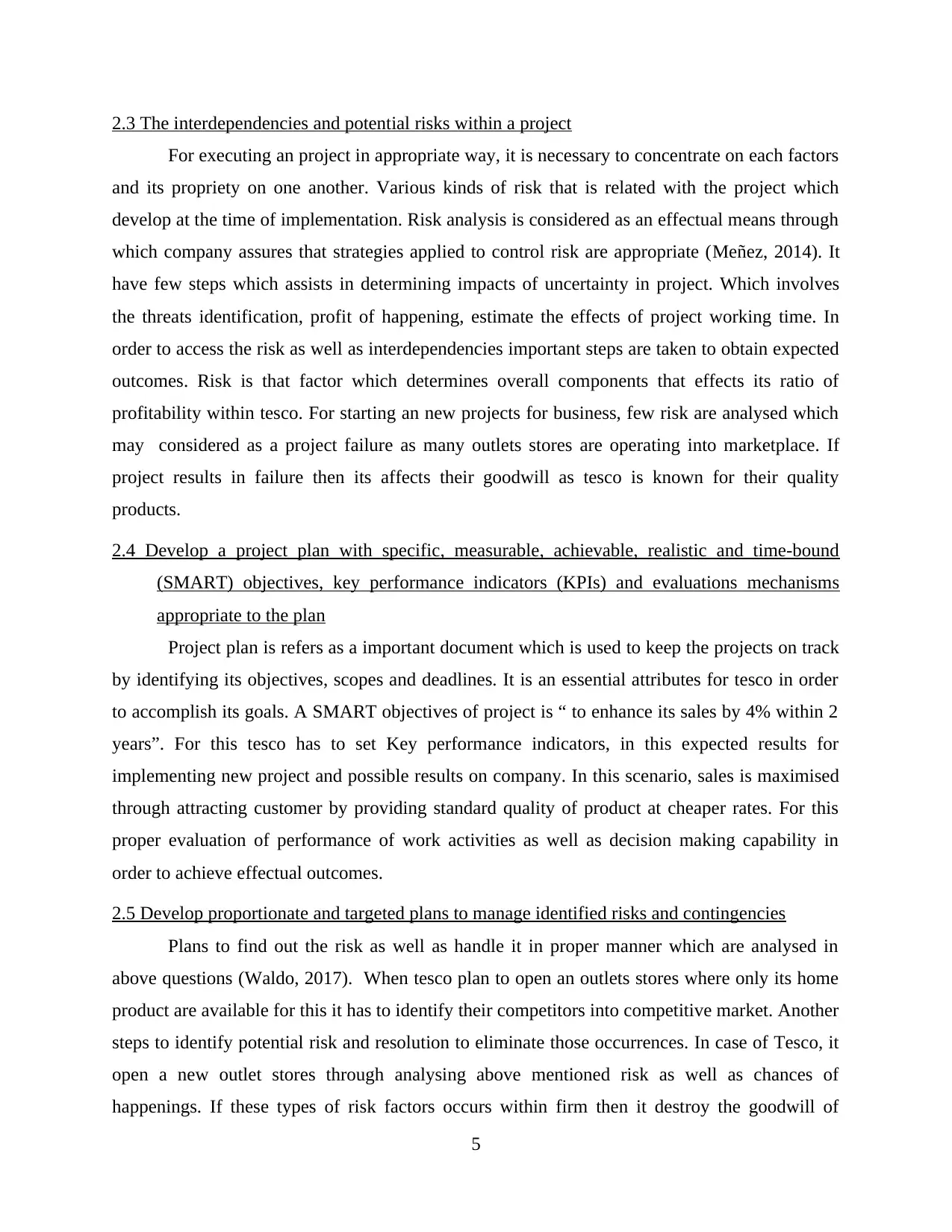
2.3 The interdependencies and potential risks within a project
For executing an project in appropriate way, it is necessary to concentrate on each factors
and its propriety on one another. Various kinds of risk that is related with the project which
develop at the time of implementation. Risk analysis is considered as an effectual means through
which company assures that strategies applied to control risk are appropriate (Meñez, 2014). It
have few steps which assists in determining impacts of uncertainty in project. Which involves
the threats identification, profit of happening, estimate the effects of project working time. In
order to access the risk as well as interdependencies important steps are taken to obtain expected
outcomes. Risk is that factor which determines overall components that effects its ratio of
profitability within tesco. For starting an new projects for business, few risk are analysed which
may considered as a project failure as many outlets stores are operating into marketplace. If
project results in failure then its affects their goodwill as tesco is known for their quality
products.
2.4 Develop a project plan with specific, measurable, achievable, realistic and time-bound
(SMART) objectives, key performance indicators (KPIs) and evaluations mechanisms
appropriate to the plan
Project plan is refers as a important document which is used to keep the projects on track
by identifying its objectives, scopes and deadlines. It is an essential attributes for tesco in order
to accomplish its goals. A SMART objectives of project is “ to enhance its sales by 4% within 2
years”. For this tesco has to set Key performance indicators, in this expected results for
implementing new project and possible results on company. In this scenario, sales is maximised
through attracting customer by providing standard quality of product at cheaper rates. For this
proper evaluation of performance of work activities as well as decision making capability in
order to achieve effectual outcomes.
2.5 Develop proportionate and targeted plans to manage identified risks and contingencies
Plans to find out the risk as well as handle it in proper manner which are analysed in
above questions (Waldo, 2017). When tesco plan to open an outlets stores where only its home
product are available for this it has to identify their competitors into competitive market. Another
steps to identify potential risk and resolution to eliminate those occurrences. In case of Tesco, it
open a new outlet stores through analysing above mentioned risk as well as chances of
happenings. If these types of risk factors occurs within firm then it destroy the goodwill of
5
For executing an project in appropriate way, it is necessary to concentrate on each factors
and its propriety on one another. Various kinds of risk that is related with the project which
develop at the time of implementation. Risk analysis is considered as an effectual means through
which company assures that strategies applied to control risk are appropriate (Meñez, 2014). It
have few steps which assists in determining impacts of uncertainty in project. Which involves
the threats identification, profit of happening, estimate the effects of project working time. In
order to access the risk as well as interdependencies important steps are taken to obtain expected
outcomes. Risk is that factor which determines overall components that effects its ratio of
profitability within tesco. For starting an new projects for business, few risk are analysed which
may considered as a project failure as many outlets stores are operating into marketplace. If
project results in failure then its affects their goodwill as tesco is known for their quality
products.
2.4 Develop a project plan with specific, measurable, achievable, realistic and time-bound
(SMART) objectives, key performance indicators (KPIs) and evaluations mechanisms
appropriate to the plan
Project plan is refers as a important document which is used to keep the projects on track
by identifying its objectives, scopes and deadlines. It is an essential attributes for tesco in order
to accomplish its goals. A SMART objectives of project is “ to enhance its sales by 4% within 2
years”. For this tesco has to set Key performance indicators, in this expected results for
implementing new project and possible results on company. In this scenario, sales is maximised
through attracting customer by providing standard quality of product at cheaper rates. For this
proper evaluation of performance of work activities as well as decision making capability in
order to achieve effectual outcomes.
2.5 Develop proportionate and targeted plans to manage identified risks and contingencies
Plans to find out the risk as well as handle it in proper manner which are analysed in
above questions (Waldo, 2017). When tesco plan to open an outlets stores where only its home
product are available for this it has to identify their competitors into competitive market. Another
steps to identify potential risk and resolution to eliminate those occurrences. In case of Tesco, it
open a new outlet stores through analysing above mentioned risk as well as chances of
happenings. If these types of risk factors occurs within firm then it destroy the goodwill of
5
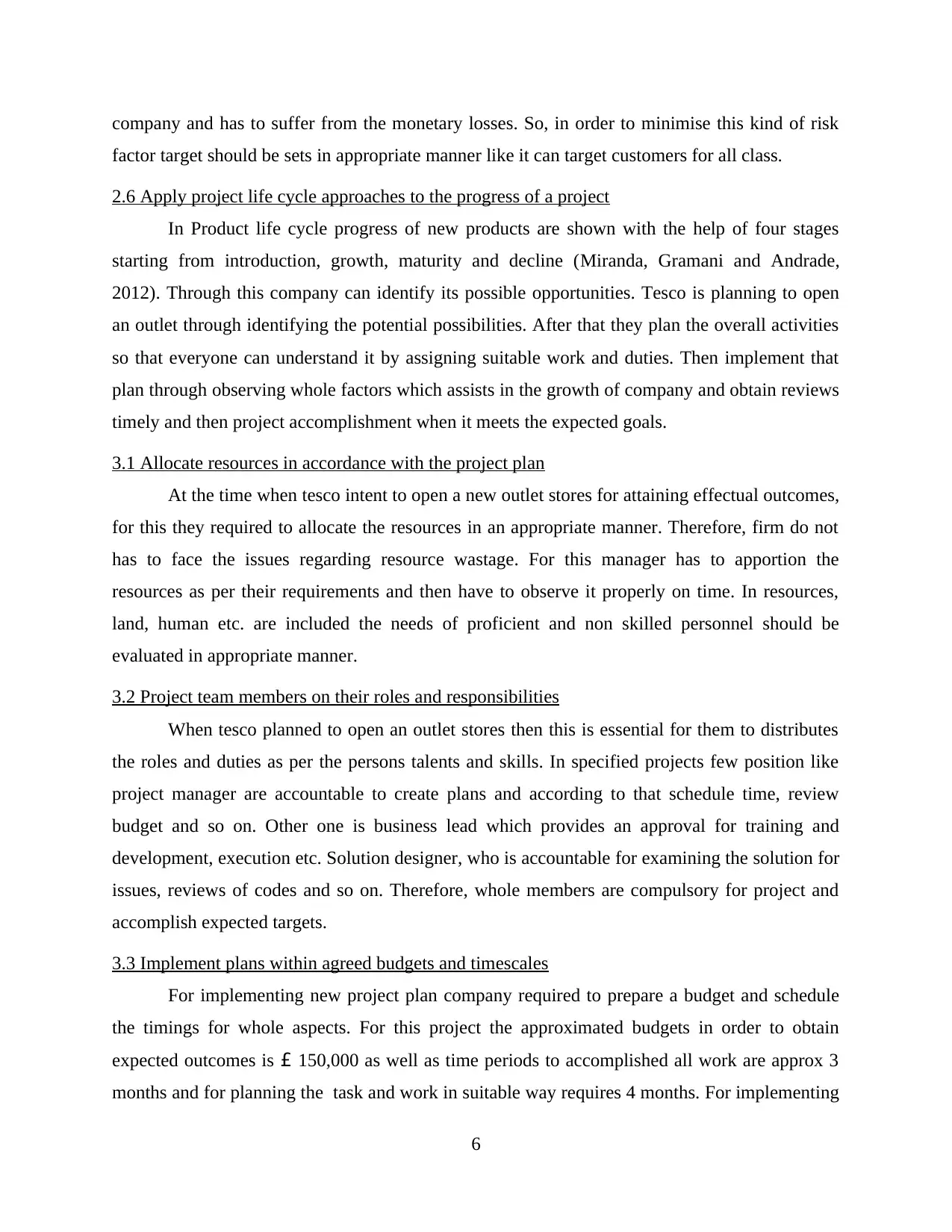
company and has to suffer from the monetary losses. So, in order to minimise this kind of risk
factor target should be sets in appropriate manner like it can target customers for all class.
2.6 Apply project life cycle approaches to the progress of a project
In Product life cycle progress of new products are shown with the help of four stages
starting from introduction, growth, maturity and decline (Miranda, Gramani and Andrade,
2012). Through this company can identify its possible opportunities. Tesco is planning to open
an outlet through identifying the potential possibilities. After that they plan the overall activities
so that everyone can understand it by assigning suitable work and duties. Then implement that
plan through observing whole factors which assists in the growth of company and obtain reviews
timely and then project accomplishment when it meets the expected goals.
3.1 Allocate resources in accordance with the project plan
At the time when tesco intent to open a new outlet stores for attaining effectual outcomes,
for this they required to allocate the resources in an appropriate manner. Therefore, firm do not
has to face the issues regarding resource wastage. For this manager has to apportion the
resources as per their requirements and then have to observe it properly on time. In resources,
land, human etc. are included the needs of proficient and non skilled personnel should be
evaluated in appropriate manner.
3.2 Project team members on their roles and responsibilities
When tesco planned to open an outlet stores then this is essential for them to distributes
the roles and duties as per the persons talents and skills. In specified projects few position like
project manager are accountable to create plans and according to that schedule time, review
budget and so on. Other one is business lead which provides an approval for training and
development, execution etc. Solution designer, who is accountable for examining the solution for
issues, reviews of codes and so on. Therefore, whole members are compulsory for project and
accomplish expected targets.
3.3 Implement plans within agreed budgets and timescales
For implementing new project plan company required to prepare a budget and schedule
the timings for whole aspects. For this project the approximated budgets in order to obtain
expected outcomes is £ 150,000 as well as time periods to accomplished all work are approx 3
months and for planning the task and work in suitable way requires 4 months. For implementing
6
factor target should be sets in appropriate manner like it can target customers for all class.
2.6 Apply project life cycle approaches to the progress of a project
In Product life cycle progress of new products are shown with the help of four stages
starting from introduction, growth, maturity and decline (Miranda, Gramani and Andrade,
2012). Through this company can identify its possible opportunities. Tesco is planning to open
an outlet through identifying the potential possibilities. After that they plan the overall activities
so that everyone can understand it by assigning suitable work and duties. Then implement that
plan through observing whole factors which assists in the growth of company and obtain reviews
timely and then project accomplishment when it meets the expected goals.
3.1 Allocate resources in accordance with the project plan
At the time when tesco intent to open a new outlet stores for attaining effectual outcomes,
for this they required to allocate the resources in an appropriate manner. Therefore, firm do not
has to face the issues regarding resource wastage. For this manager has to apportion the
resources as per their requirements and then have to observe it properly on time. In resources,
land, human etc. are included the needs of proficient and non skilled personnel should be
evaluated in appropriate manner.
3.2 Project team members on their roles and responsibilities
When tesco planned to open an outlet stores then this is essential for them to distributes
the roles and duties as per the persons talents and skills. In specified projects few position like
project manager are accountable to create plans and according to that schedule time, review
budget and so on. Other one is business lead which provides an approval for training and
development, execution etc. Solution designer, who is accountable for examining the solution for
issues, reviews of codes and so on. Therefore, whole members are compulsory for project and
accomplish expected targets.
3.3 Implement plans within agreed budgets and timescales
For implementing new project plan company required to prepare a budget and schedule
the timings for whole aspects. For this project the approximated budgets in order to obtain
expected outcomes is £ 150,000 as well as time periods to accomplished all work are approx 3
months and for planning the task and work in suitable way requires 4 months. For implementing
6
⊘ This is a preview!⊘
Do you want full access?
Subscribe today to unlock all pages.

Trusted by 1+ million students worldwide
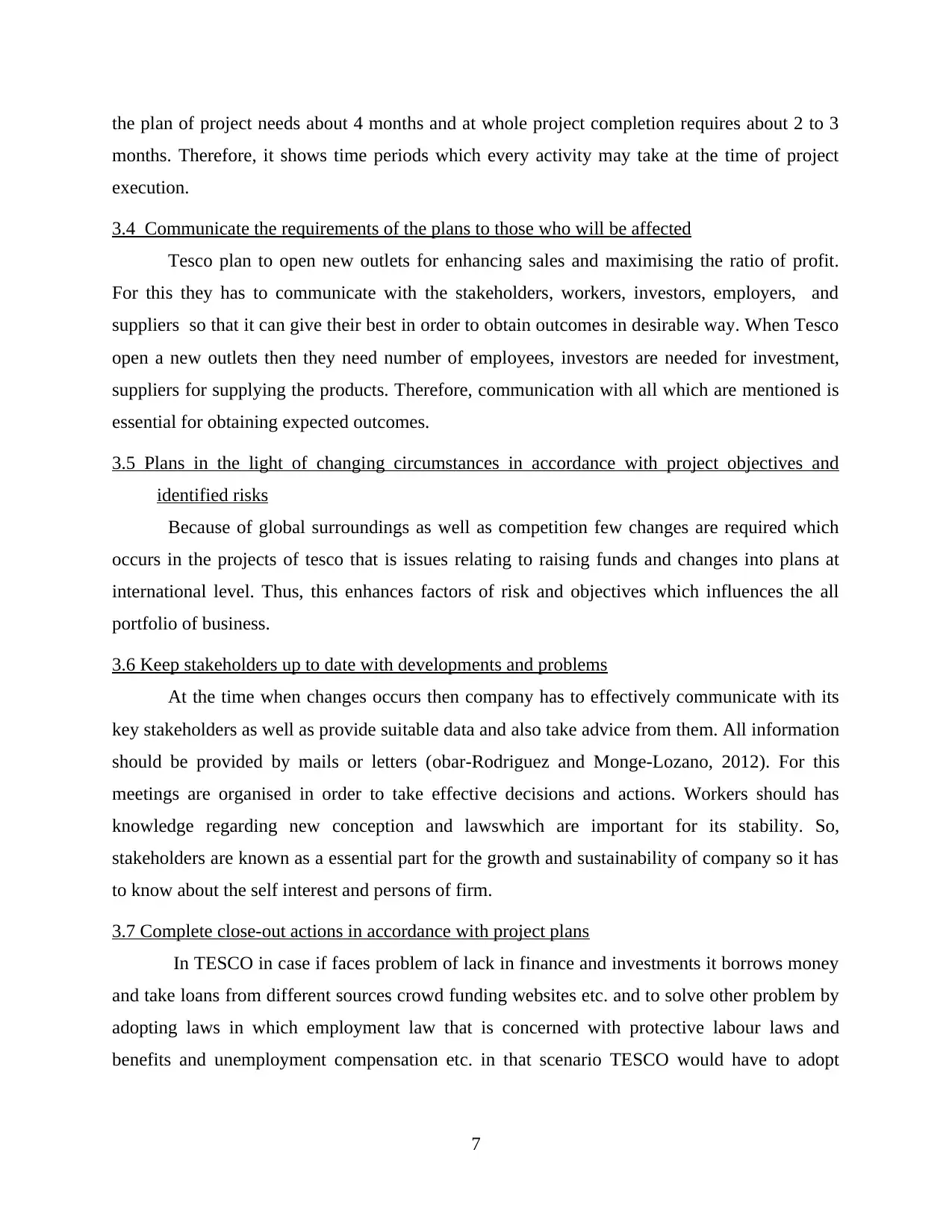
the plan of project needs about 4 months and at whole project completion requires about 2 to 3
months. Therefore, it shows time periods which every activity may take at the time of project
execution.
3.4 Communicate the requirements of the plans to those who will be affected
Tesco plan to open new outlets for enhancing sales and maximising the ratio of profit.
For this they has to communicate with the stakeholders, workers, investors, employers, and
suppliers so that it can give their best in order to obtain outcomes in desirable way. When Tesco
open a new outlets then they need number of employees, investors are needed for investment,
suppliers for supplying the products. Therefore, communication with all which are mentioned is
essential for obtaining expected outcomes.
3.5 Plans in the light of changing circumstances in accordance with project objectives and
identified risks
Because of global surroundings as well as competition few changes are required which
occurs in the projects of tesco that is issues relating to raising funds and changes into plans at
international level. Thus, this enhances factors of risk and objectives which influences the all
portfolio of business.
3.6 Keep stakeholders up to date with developments and problems
At the time when changes occurs then company has to effectively communicate with its
key stakeholders as well as provide suitable data and also take advice from them. All information
should be provided by mails or letters (obar-Rodriguez and Monge-Lozano, 2012). For this
meetings are organised in order to take effective decisions and actions. Workers should has
knowledge regarding new conception and lawswhich are important for its stability. So,
stakeholders are known as a essential part for the growth and sustainability of company so it has
to know about the self interest and persons of firm.
3.7 Complete close-out actions in accordance with project plans
In TESCO in case if faces problem of lack in finance and investments it borrows money
and take loans from different sources crowd funding websites etc. and to solve other problem by
adopting laws in which employment law that is concerned with protective labour laws and
benefits and unemployment compensation etc. in that scenario TESCO would have to adopt
7
months. Therefore, it shows time periods which every activity may take at the time of project
execution.
3.4 Communicate the requirements of the plans to those who will be affected
Tesco plan to open new outlets for enhancing sales and maximising the ratio of profit.
For this they has to communicate with the stakeholders, workers, investors, employers, and
suppliers so that it can give their best in order to obtain outcomes in desirable way. When Tesco
open a new outlets then they need number of employees, investors are needed for investment,
suppliers for supplying the products. Therefore, communication with all which are mentioned is
essential for obtaining expected outcomes.
3.5 Plans in the light of changing circumstances in accordance with project objectives and
identified risks
Because of global surroundings as well as competition few changes are required which
occurs in the projects of tesco that is issues relating to raising funds and changes into plans at
international level. Thus, this enhances factors of risk and objectives which influences the all
portfolio of business.
3.6 Keep stakeholders up to date with developments and problems
At the time when changes occurs then company has to effectively communicate with its
key stakeholders as well as provide suitable data and also take advice from them. All information
should be provided by mails or letters (obar-Rodriguez and Monge-Lozano, 2012). For this
meetings are organised in order to take effective decisions and actions. Workers should has
knowledge regarding new conception and lawswhich are important for its stability. So,
stakeholders are known as a essential part for the growth and sustainability of company so it has
to know about the self interest and persons of firm.
3.7 Complete close-out actions in accordance with project plans
In TESCO in case if faces problem of lack in finance and investments it borrows money
and take loans from different sources crowd funding websites etc. and to solve other problem by
adopting laws in which employment law that is concerned with protective labour laws and
benefits and unemployment compensation etc. in that scenario TESCO would have to adopt
7
Paraphrase This Document
Need a fresh take? Get an instant paraphrase of this document with our AI Paraphraser
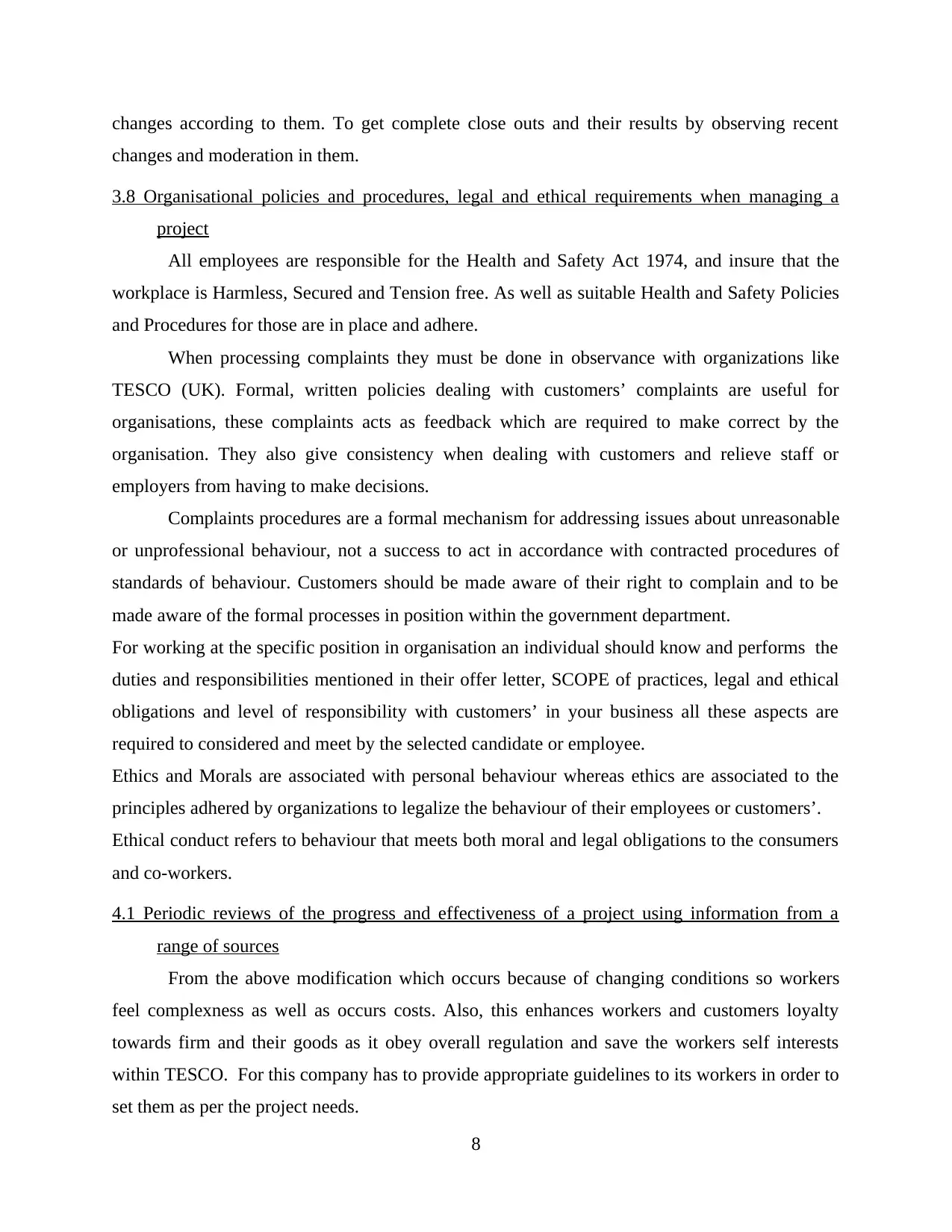
changes according to them. To get complete close outs and their results by observing recent
changes and moderation in them.
3.8 Organisational policies and procedures, legal and ethical requirements when managing a
project
All employees are responsible for the Health and Safety Act 1974, and insure that the
workplace is Harmless, Secured and Tension free. As well as suitable Health and Safety Policies
and Procedures for those are in place and adhere.
When processing complaints they must be done in observance with organizations like
TESCO (UK). Formal, written policies dealing with customers’ complaints are useful for
organisations, these complaints acts as feedback which are required to make correct by the
organisation. They also give consistency when dealing with customers and relieve staff or
employers from having to make decisions.
Complaints procedures are a formal mechanism for addressing issues about unreasonable
or unprofessional behaviour, not a success to act in accordance with contracted procedures of
standards of behaviour. Customers should be made aware of their right to complain and to be
made aware of the formal processes in position within the government department.
For working at the specific position in organisation an individual should know and performs the
duties and responsibilities mentioned in their offer letter, SCOPE of practices, legal and ethical
obligations and level of responsibility with customers’ in your business all these aspects are
required to considered and meet by the selected candidate or employee.
Ethics and Morals are associated with personal behaviour whereas ethics are associated to the
principles adhered by organizations to legalize the behaviour of their employees or customers’.
Ethical conduct refers to behaviour that meets both moral and legal obligations to the consumers
and co-workers.
4.1 Periodic reviews of the progress and effectiveness of a project using information from a
range of sources
From the above modification which occurs because of changing conditions so workers
feel complexness as well as occurs costs. Also, this enhances workers and customers loyalty
towards firm and their goods as it obey overall regulation and save the workers self interests
within TESCO. For this company has to provide appropriate guidelines to its workers in order to
set them as per the project needs.
8
changes and moderation in them.
3.8 Organisational policies and procedures, legal and ethical requirements when managing a
project
All employees are responsible for the Health and Safety Act 1974, and insure that the
workplace is Harmless, Secured and Tension free. As well as suitable Health and Safety Policies
and Procedures for those are in place and adhere.
When processing complaints they must be done in observance with organizations like
TESCO (UK). Formal, written policies dealing with customers’ complaints are useful for
organisations, these complaints acts as feedback which are required to make correct by the
organisation. They also give consistency when dealing with customers and relieve staff or
employers from having to make decisions.
Complaints procedures are a formal mechanism for addressing issues about unreasonable
or unprofessional behaviour, not a success to act in accordance with contracted procedures of
standards of behaviour. Customers should be made aware of their right to complain and to be
made aware of the formal processes in position within the government department.
For working at the specific position in organisation an individual should know and performs the
duties and responsibilities mentioned in their offer letter, SCOPE of practices, legal and ethical
obligations and level of responsibility with customers’ in your business all these aspects are
required to considered and meet by the selected candidate or employee.
Ethics and Morals are associated with personal behaviour whereas ethics are associated to the
principles adhered by organizations to legalize the behaviour of their employees or customers’.
Ethical conduct refers to behaviour that meets both moral and legal obligations to the consumers
and co-workers.
4.1 Periodic reviews of the progress and effectiveness of a project using information from a
range of sources
From the above modification which occurs because of changing conditions so workers
feel complexness as well as occurs costs. Also, this enhances workers and customers loyalty
towards firm and their goods as it obey overall regulation and save the workers self interests
within TESCO. For this company has to provide appropriate guidelines to its workers in order to
set them as per the project needs.
8
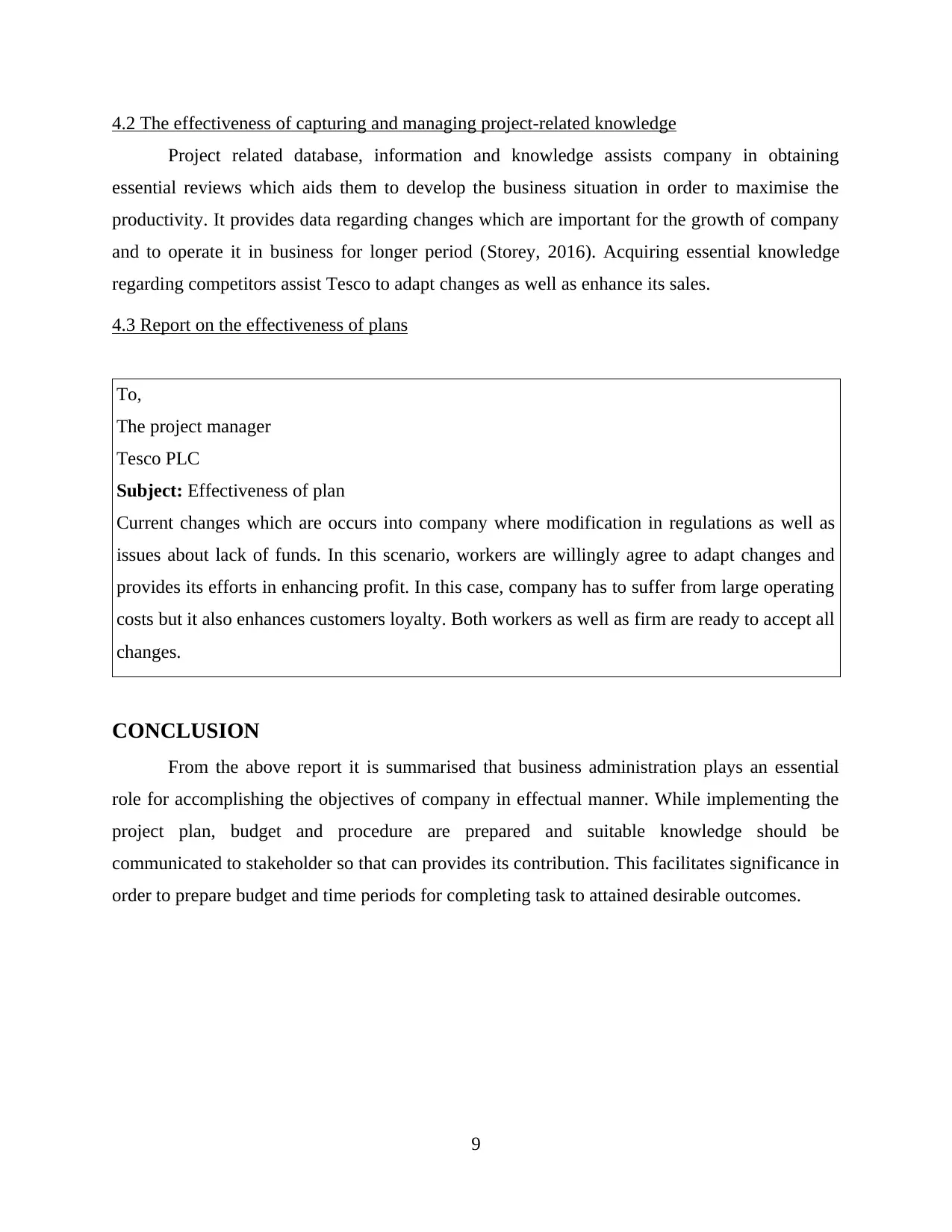
4.2 The effectiveness of capturing and managing project-related knowledge
Project related database, information and knowledge assists company in obtaining
essential reviews which aids them to develop the business situation in order to maximise the
productivity. It provides data regarding changes which are important for the growth of company
and to operate it in business for longer period (Storey, 2016). Acquiring essential knowledge
regarding competitors assist Tesco to adapt changes as well as enhance its sales.
4.3 Report on the effectiveness of plans
To,
The project manager
Tesco PLC
Subject: Effectiveness of plan
Current changes which are occurs into company where modification in regulations as well as
issues about lack of funds. In this scenario, workers are willingly agree to adapt changes and
provides its efforts in enhancing profit. In this case, company has to suffer from large operating
costs but it also enhances customers loyalty. Both workers as well as firm are ready to accept all
changes.
CONCLUSION
From the above report it is summarised that business administration plays an essential
role for accomplishing the objectives of company in effectual manner. While implementing the
project plan, budget and procedure are prepared and suitable knowledge should be
communicated to stakeholder so that can provides its contribution. This facilitates significance in
order to prepare budget and time periods for completing task to attained desirable outcomes.
9
Project related database, information and knowledge assists company in obtaining
essential reviews which aids them to develop the business situation in order to maximise the
productivity. It provides data regarding changes which are important for the growth of company
and to operate it in business for longer period (Storey, 2016). Acquiring essential knowledge
regarding competitors assist Tesco to adapt changes as well as enhance its sales.
4.3 Report on the effectiveness of plans
To,
The project manager
Tesco PLC
Subject: Effectiveness of plan
Current changes which are occurs into company where modification in regulations as well as
issues about lack of funds. In this scenario, workers are willingly agree to adapt changes and
provides its efforts in enhancing profit. In this case, company has to suffer from large operating
costs but it also enhances customers loyalty. Both workers as well as firm are ready to accept all
changes.
CONCLUSION
From the above report it is summarised that business administration plays an essential
role for accomplishing the objectives of company in effectual manner. While implementing the
project plan, budget and procedure are prepared and suitable knowledge should be
communicated to stakeholder so that can provides its contribution. This facilitates significance in
order to prepare budget and time periods for completing task to attained desirable outcomes.
9
⊘ This is a preview!⊘
Do you want full access?
Subscribe today to unlock all pages.

Trusted by 1+ million students worldwide
1 out of 14
Related Documents
Your All-in-One AI-Powered Toolkit for Academic Success.
+13062052269
info@desklib.com
Available 24*7 on WhatsApp / Email
![[object Object]](/_next/static/media/star-bottom.7253800d.svg)
Unlock your academic potential
Copyright © 2020–2025 A2Z Services. All Rights Reserved. Developed and managed by ZUCOL.





